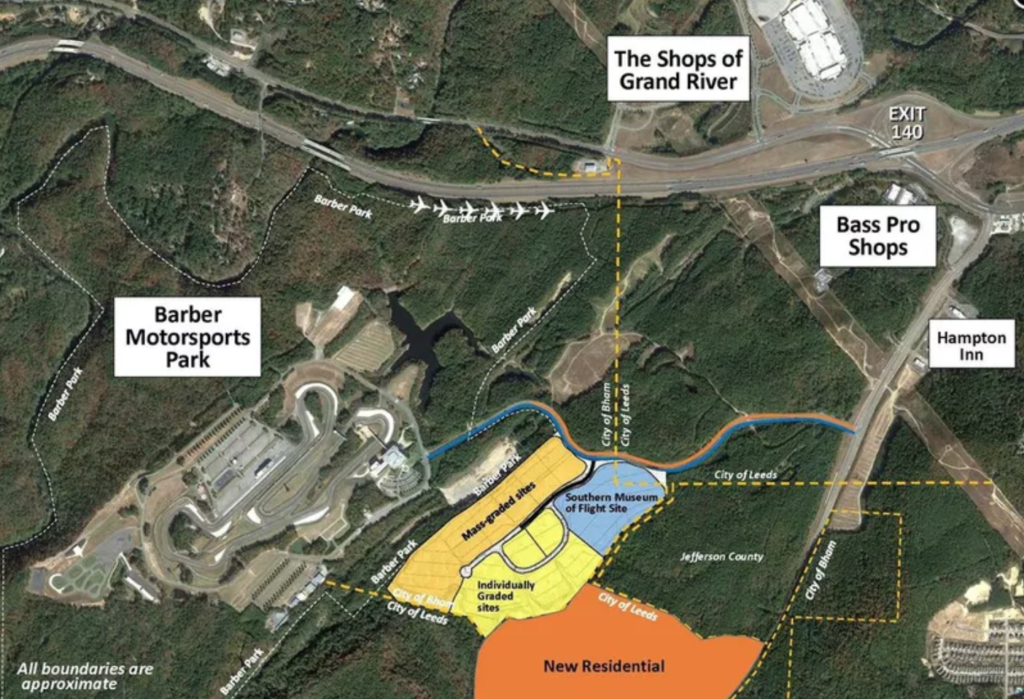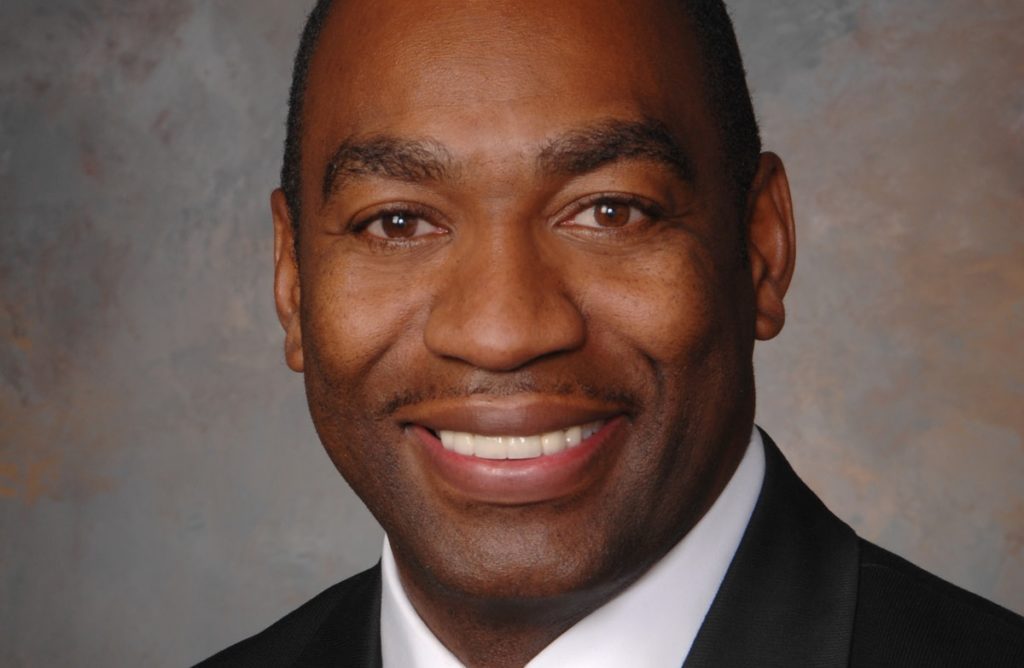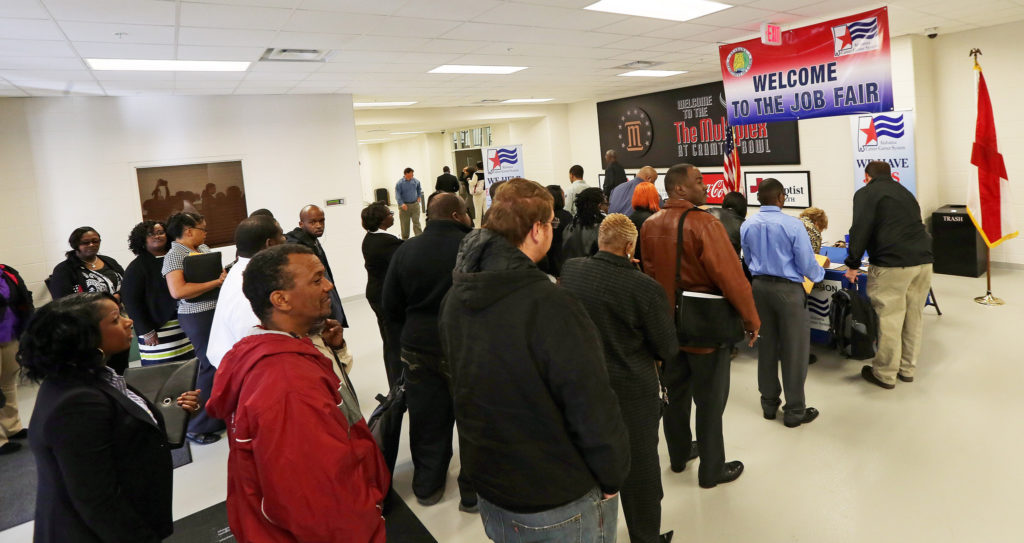Alabama unemployment rate drops to 3.9 percent

Alabama’s unemployment rate dropped ever so slightly in December. The Alabama Department of Labor (ADOL) said December’s seasonally adjusted jobless rate is 3.9 percent — a decrease from November’s 4 percent. “We are ending 2018 with great economic news all around,” said Alabama Department of Labor Secretary Fitzgerald Washington. “To see this kind of record job growth is extraordinary. Alabama employers have added nearly 45,000 jobs over the past year – economists predicted that our economy would grow by 27,000 jobs. I’m happy to say that we more than exceeded their predictions.” For seven consecutive months, the number of people counted as employed has reached record highs, with December’s count measuring 2,130,194, an increase from November’s count of 2,127,934, and an increase of 49,018 compared to December 2017’s count of 2,081,176. December’s rate represents 86,023 unemployed persons, compared to 87,754 in November and 82,378 in December 2017. Counties with the lowest unemployment rates are: Shelby County: 2.5% Cullman County: 2.9% Marshall, Madison, Limestone, and Elmore Counties: 3.0% Counties with the highest unemployment rates are: Wilcox County: 8.7% Clarke County: 7.1% Dallas County: 6.6%. Major cities with the lowest unemployment rates are: Homewood and Vestavia Hills: 2.3% Alabaster, Hoover, Madison, and Northport: 2.5% Daphne: 2.9% Major cities with the highest unemployment rates are: Selma: 7.9% Prichard: 6.3% Bessemer: 4.8%
Alabama’s unemployment holds steady at 3.8 percent

Alabama’s jobs market has held steady through the first quarter of 2018, with the unemployment rate coming in at 3.8 percent in April — the same as it was in March. According to numbers released Friday by the Alabama Department of Labor (ADOL), the unemployment rate has held in the 3.7 – 3.8 percent range all year, with January and February at the slightly improved rate of 3.7 percent. “The good news just keeps coming in Alabama,” Governor Kay Ivey said. “Our workforce is growing, more people are working, and businesses are moving to our great state. We are proud of how much we’ve improved, and are working hard to build on that momentum.” According to ADOL statistic, 2,086,659 people were counted as employed in April, an increase of 19,877 from last year. Additionally, average weekly earnings increased $41.92 over the year with wages in the construction, manufacturing, trade, transportation, and utilities, financial activities, professional and business services, education and health services, and leisure and hospitality sectors all increased over the year. “All 67 Alabama counties experienced rate drops both over the month and over the year,” said Fitzgerald Washington, Secretary of the Alabama Department of Labor. “Wilcox County, which traditionally has the highest unemployment rate in Alabama, saw its rate drop by 2.2 percentage points over the year.” Counties with the lowest unemployment rates are: Shelby County: 2.6% Cullman County: 2.8% Marshall, Madison, and Elmore Counties: 3.0% Counties with the highest unemployment rates are: Wilcox County: 8.6% Clarke and Lowndes Counties: 6.6% Greene County: 6.0%. Major cities with the lowest unemployment rates are: Homewood and Vestavia Hills: 2.2% Alabaster: 2.5% Hoover, Madison, and Northport: 2.6% Major cities with the highest unemployment rates are: Prichard: 6.1% Selma: 6.0% Anniston: 5.2%.
Proposed industrial park, community to receive $6 million

A proposed high-tech industrial park and residential community near Barber Motorsports in Alabama could receive $6 million in federal grants. The funds could help push forward development of the project that could create more than 1,200 jobs, Al.com reported. The Alabama Department of Labor says the project could generate an economic impact of more than $85 million in Birmingham. The Alabama Department of Labor announced Wednesday that the state has been given preliminary approval to distribute $10 million in federal grant funds to three projects. Work on the projects is expected to begin this summer. The project is called the Grand River Technology and Grand River Homes. The Surface Mining Reclamation and Enforcement’s federal office gave the approval. It was a part of the 2017 AML Pilot Program to revitalize Alabama’s coalfields region. Along with the Grand River development, the other projects are in the cities of Helena and Vestavia Hills. In November, the Birmingham City Council approved entering into an agreement with U.S. Steel to pay up to $4.6 million for some site work to prepare 40 acres south of Barber Motorsports Park for the industrial park. U.S. Steel will deed 24 acres near the site over to the city for the relocation of the Southern Museum of Flight. The development agreement says the city’s investment will pay for the construction of a partial road and grading of the property. U.S. Steel, Birmingham, Southern Museum of Flight, Jefferson County and Leeds has partnered on the project. Republished with permission from the Associated Press.
Steve Flowers: An exciting time for Alabama community Colleges

In March of this year, the Alabama Community College System took a giant leap forward when it brought on a giant in state government and one of Alabama’s preeminent leaders, Jimmy Baker, to be Chancellor. When you have a conversation with Chancellor Baker, he uses words that you do not normally hear in the same sentence, like exciting and community college. He says it is an exciting time. For a myriad of reasons, across the state, community colleges and technical training have been viewed as second best when it comes to higher education options. Sit down with Chancellor Baker and you will leave convinced that Alabama’s community colleges can do more to move the state forward than any other entity in the state. For an institution that in the past had a history of caring a lot about buildings, he is singularly focused on doing what is in the best interest of students. To him, that means an open door policy at every college across the system. Anyone looking to better themselves should be able to walk in the door and find opportunity at their local community college. For some that opportunity looks like core academic coursework to transfer to a four-year or advanced degree at a fraction of the cost. For others that means stackable credentials and skills training to leave the classroom and step directly into a career. It could also mean general literacy and workforce skills or specific job training for a specific industry. The paths are as varied as the student population, which ranges from high school students participating in dual enrollment classes to adult learners who are seeking to advance their careers and everything in between. The Alabama Community College System consists of 24 community and technical colleges residing in each of the state’s urban centers as well as rural locales across the state. Additionally, extensive workforce development training for Alabama business and industry through the Alabama Technology Network also resides within the system. Baker argues that the system’s reach across the state and each college’s connection with their local community makes them the most adaptable, allowing each college to made adjustments based on the needs of their service area. Imagine if this were the case in every community: a new auto manufacturer announces 200 jobs in Anytown, Alabama and the local Anytown Community College is already working to adapt courses and training to ensure the workforce is ready. Anyone familiar with Alabama realizes the dramatic change in the economy over the past half-century. Entire industries have disappeared, replaced with new technology based careers requiring a different knowledge base. The System is committed to being part of the solution. Baker knows that means being honest with students about opportunities that are available and the education, skills, and training needed to secure them. The Alabama Department of Labor estimates that there are more than 14,000 industrial manufacturing and transportation job openings each year. The Alabama Community College System is addressing the issue head-on by partnering with the state to provide two certification programs that upon completion translate into a job in manufacturing or production. Alabama is the first state in the nation to roll out these certifications statewide. The System also made headlines when it was selected as one of only six community colleges systems in the entire country by Apple, Inc. to launch a new app-development curriculum. Students who participate in the courses will learn coding and app development with Apple’s Swift programming language, preparing them for a wide variety of careers in our ever-increasing technology driven economy. While workforce training is a key mission of the ACCS, equal to its focus is to provide Alabama students with the academic coursework they need to be successful. A great number of students come to the community college to take coursework to prepare them to transition to a four-year institution. These students are receiving the same quality of coursework and instruction as they would at other institutions but with smaller class sizes and less cost. Over the past several years, thanks to support from the Alabama Legislature, dual enrollment has continued to expand across the state. Students can take courses and receive both high school and college credit. In many instances, scholarships or grant funds are provided so students are afforded this opportunity at no cost to them. Students who participate will not only graduate high school with college credits under their belt but they will also be more prepared for the rigors of college having already experienced a college classroom. See you next week. ••• Steve Flowers is Alabama’s leading political columnist. His weekly column appears in over 60 Alabama newspapers. He served 16 years in the state legislature. Steve may be reached at www.steveflowers.us.
Alabama unemployment rate drops to 6.2 percent

The Alabama unemployment rate dropped two tenths of a point in February compared with the previous month. According to its preliminary unemployment estimates the Alabama Department of Labor (ADOL) reports 13,205 seasonally-adjusted jobs were added in the private sector last month, which is 30,728 more people employed than February one year ago. That change drops the state’s January unemployment rate of 6.4% down to 6.2%. “We are once again announcing that we have more people working in Alabama than have been over the last eight years,” said ADOL Secretary Fitzgerald Washington. “The labor force continues to grow, showing that jobseekers have confidence in our economy and are willing to enter the job market. Wage and salary employment is fewer than 20,000 jobs away from reaching the two million-mark milestone. We aren’t exactly where we need to be yet, but we are surely getting there.” Alabama’s civilian labor force measured 2,203,868 in February, the highest it’s been since June 2011, when it measured 2,202,354. “All of our counties and metros saw their rates drop this month, and 57 counties and 11 metros saw over-the -year declines,” continued Washington. Counties with the lowest unemployment rates are: Shelby County: 4.5% Elmore County: 5.0% Madison and Lee Counties: 5.2% Counties with the highest unemployment rates are: Wilcox County: 14.9% Clarke County: 11.2% Lowndes County: 10.7% Major cities with the lowest unemployment rates are: Vestavia Hills: 4.0% Homewood: 4.1% Hoover: 4.3% Major cities with the highest unemployment rates are: Selma: 10.8% Prichard: 10.3% Bessemer: 8.5%.
Even as state adds jobs, Alabama unemployment rate rises to 6.4 percent

The unemployment rate in Alabama has ticked up slightly, even as the state added 6,500 jobs in January. The Alabama Department of Labor said Monday the January rate increased by one percentage point, to 6.4 percent. The department noted that despite the increase, the state still has more people working than it has in eight years. “Our unemployment rate rose because nearly 10,000 more people entered the labor force last month, and about 6,500 of them found work,” said Alabama Labor Secretary Fitzgerald Washington. “The others remain unemployed. When you have an increase in the labor force, and all of those people aren’t able to find work, you will see up an uptick in the rate.” Washington continued, “However, there is good news in this month’s economic report. We continue to surpass our employment numbers each month, and once again, I can say that we currently have more people working in Alabama than there have been in more than eight years. Our labor force is larger than it has been in more than five years.” Major cities with the lowest unemployment rates are: Vestavia Hills: 3.7% Homewood: 3.9% Hoover: 4.0% Major cities with the highest unemployment rates are: Selma: 10.2% Prichard: 9.5%, Bessemer: 8.9%.
Fitzgerald Washington: Alabama’s workforce continues to grow

We’re at the beginning of another year, and ready to see continued improvement in our economy. At the Alabama Department of Labor, we are busy wrapping up the facts and figures for 2016. There were many improvements last year, and I’d like to let people know about them. We ended the year with our wage and salary employment only 17,000 jobs away from reaching two million. I can’t emphasize how great this news is! The last time our economy supported two million jobs was back in 2007, before the recession, before tens of thousands of Alabamians were relying on unemployment compensation to help support their families, and before our unemployment levels reached record highs. A wage and salary employment level of two million is considered to be a benchmark employment figure. I’m hopeful that we’ll reach that milestone in 2017. As employers’ confidence was sustained and hiring rose, Alabamians continue to join the workforce. We ended 2016 with the largest workforce we’ve had in more than five years. Additionally, more people were working in December 2016 than at any time since April 2008. Employers are hiring, and workers are working. Those who don’t have jobs are looking for jobs, which tells us they believe there are jobs to be had. All of these are positive signs for our economy. Our manufacturing industry continues to lead our economy. In 2016, Alabama ranked third nation-wide in manufacturing employment growth (year over year December). These competitive, sought-after jobs carry wages of more than $20 an hour. As far as unemployment compensation goes, the amount we are paying in benefits and the number of people filing for those benefits are at seven year lows. Those who are receiving benefits are only doing so, on average, for around 14 weeks, which is significantly less than during the recession, when up to 99 weeks were available and some were using all of them. Last year, we paid out over $183 million in Work Opportunity Tax Credits, more than $71 million higher than in 2015. These are credits that employers can take advantage of when they hire certain individuals, such as the long-term unemployed and food stamp recipients, among others. These are dollars that are going right back into our economy to spur spending and encourage hiring. Job orders on the state’s free jobs database, joblink.alabama.gov, were at five year highs, with several months registering more than 30,000 orders! With all of these positives, we still realize that there is work to be done. Even though there are more people working now than in nearly a decade, there are still more than 130,000 Alabamians who are out of work. Our mission, just like that of Governor Robert Bentley, is to make sure that these citizens have the opportunity to get a job, to support their families, and to live a quality life. In order to meet these obligations, we’re setting a few goals: First, we’re aiming to keep 2017’s yearly average unemployment rate below the yearly average unemployment rate of 2016 (5.9%). In order to keep the unemployment rate low, it’s important that we maintain employment levels. This means working with the Governor, state agencies, economic development groups, and local governments in order to keep jobs in Alabama and recruit new ones. Since taking office in 2011, Governor Bentley’s administration recruited 92,000 jobs to the state. These cooperative agreements are beneficial to all involved. We’re also focusing our efforts to surpass economists’ estimates for job growth in 2017. In January of this year, economists predicted that Alabama will gain 18,700 jobs in 2017. We hope to surpass that number, as we have for the past three years. In 2016, the prediction was for growth of 29,450. For the period covering January 2016 to December 2016, jobs grew by 49,600, bypassing the predictions by 20,150! Again, as employers maintain their confidence in the economy and continue to hire, hopefully, this goal will be an easy one to meet. We want to increase awareness of free, valuable services available at our 49 Career Centers located throughout the state. Our Career Centers offer so many wonderful services for both jobseekers and employers. The best part is that they are offered at no charge! Nearly half a million Alabamians were served in 2016, and we hope to increase that number this year. Our regional job fairs, hosted in Montgomery, Dothan, and Birmingham last year, drew more than 12,000 jobseekers to speak with more than 400 employers. We’re bringing our job fairs to other regions of the state this year. Come out and see us! Find out more information about any of our services at labor.alabama.gov. ••• Fitzgerald Washington is the Secretary of the Alabama Department of Labor
New unemployment debit cards coming to Alabama in 2017

Alabamians receiving unemployment benefits will soon be getting new debit cards. The Alabama Department of Labor (ADOL) said in a news release the agency is changing service providers and will be mailing out new cards in January. All recipients currently using a debit card will receive a new one. Recipients who are receiving benefits via direct deposit to a personal bank account will not be affected by this change ADOL strongly encourages unemployment recipients to ensure that the Department has a valid, current address on file and any updates are made prior to January 1. Changes may be made by calling 1-800-361-4524 or by visiting https://labor.alabama.gov/uc/ICCS/default.aspx and selecting “change personal information.”
Alabama unemployment rate lowest since 2008

Alabama’s total unemployment rate continued to fall in August, dropping to 5.7 percent from the June rate of 6.1 percent, according to data released Friday by Gov. Robert Bentley‘s office. July’s rate represents 123,095 unemployed persons, compared to 130,298 in June and 130,098 in July 2015. “We continue to see decreases in Alabama’s unemployment rate, and increases in both of our employment measures over the year, which is a testament to the strong economic development efforts we have prioritized,” Bentley said in a news release. “We haven’t seen an unemployment rate this low in eight years. Not only did the rate decrease since last month, there are also nearly 28,000 more people working this year than there were last year.” “July registered the fewest number of unemployed people since 2008 and the good news also trickled down to the counties this month as well,” Alabama Department of Labor Secretary Fitzgerald Washington said. All major Alabama cities, metro areas, and 66 Alabama counties experienced drops in the unemployment rate. Fitzgerald continued, “Every county in Alabama saw its rate decrease over the month, and 66 of 67 counties saw their rates decrease over the year, some by more than two percentage points. This is excellent news!” Counties with the lowest unemployment rates are: Shelby County: 4.2% Elmore County:4.7% Baldwin County: 4.8% Counties with the highest unemployment rates are: Wilcox County: 14.3% Perry County: 12.1% Clarke County: 11.4%
Email insights: Robert Bentley announces Alabama regional job fairs are putting Alabamians back to work

Gov. Robert Bentley issued a statement Monday on the success of Regional Jobs Fairs after having recently received a presentation from Alabama Department of Labor (ADOL) Commissioner Fitzgerald Washington on the successful outcome of the fairs that are being hosted by ADOL across the Yellowhammer state. The job fairs initiative began nearly one year ago when ADOL launched an effort to bring down unemployment rates in counties with traditionally high rates. Accordingly to Bentley, as of May 2016, four of the five underserved counties have experienced significant drops in their unemployment rates. Read Bentley’s full statement here: Governor Robert Bentley received a presentation from Alabama Department of Labor Commissioner Fitzgerald Washington on the successful outcome of the Regional Job Fairs that are being hosted by the Department of Labor throughout the state. Approximately one year ago, the Department launched an effort aimed at bringing down unemployment rates in counties with traditionally high rates. By working with local government and education officials, ADOL was able to bring employers to these mostly rural areas and connect job seekers with jobs. Over the course of 2015, five job fairs were held in Dallas, Greene, Lowndes, Perry, and Wilcox counties. “Putting Alabamians back to work is a key part of my Great State 2019 plan,” Governor Robert Bentley said. “Anytime we have an opportunity to connect hundreds of employers with thousands of job seekers, everyone benefits. For an example, in Wilcox County the pre-job fair unemployment rate was 16.5%, now the post-job fair unemployment rate is 13.5%.” As of May 2016, four of the five underserved counties have experienced significant drops in their unemployment rates. In 2016, laid-off coal miners and steel workers dominated the headlines. ADOL took a more targeted approach and conducted two job fairs in the West Alabama area, aimed at helping these workers get back on their feet. More than 1,500 job seekers turned out to meet with over 100 employers. Additionally, a plan was put into place to bring the job fairs to the general public. So far, regional job fairs have been held in Tuscaloosa, Montgomery and Birmingham, with attendance nearing 10,000. Hundreds of unemployed Alabamians have found work through these efforts, and more regional job fairs are scheduled throughout the year. Following the Montgomery job fair in February, Todd Butler landed a management position at Home Depot. “I was out of a job, been looking for a couple of months,” Butler said. “I couldn’t believe the amount of people at the job fair.” Butler was one of 3,300 people who attended the job fair back in February. He spoke to 30 companies that day, with Home Depot being his top choice. He says the new job has brought a new challenge and new focus to his life. “It’s limitless,” Butler said. “Home Depot is the largest home improvement company in the world. So, there’s only upward to go from here.” “With each job fair we host, we are finding more and more interest, both from employers and job seekers,” said Washington. “People are eager to put their best foot forward and find meaningful employment, and employers are constantly looking for great employees. We are pleased to be able to offer these services free of charge and are always looking for new and innovative ways to help Alabamians go back to work.” Four additional job fairs are scheduled for 2016 in the following areas: in August a Maritime Job Fair will be held in Mobile, in September a job fair will be held in the Wiregrass Area, in October the Governor’s Disability Summit will be held in Birmingham, and in November a second job fair will be held in Montgomery. For more information on seeking a job visit Alabama job link.
State Department of Labor attends WIOA Convention in Washington, D.C.

A delegation from the Alabama Department of Labor (ADOL) attended the Workforce Innovation and Opportunity Act (WIOA) Convention in Washington, a one-time meeting of state workforce partners to assist in finalizing the act, which will take effect July 1, and have been using Twitter to update followers on the convention’s movements. Six representatives from the department attended the event at a cost of $395 per person, paid for with grant money, including: Commissioner Fitzgeral Washington, Employment Services Director Robert Brantley, Area Managers Brinda Barrett and Ruby Beezley, Labor Market Information Assistant Director Tonya Lee and Employment Security Senior Manager Stephen Smith. The act is designed to consolidate job training programs under the Workforce Investment Act of 1998 into a single funding stream, amend the Wagner-Peyser Act, reauthorize programs for adult education and programs under the 1973 Rehabilitation Act. “Our staff is able to network with similar staff across the country to discuss issues related to the upcoming implementation of this very complex legislation,” said ADOL Communications Director Tara Hutchison. “There are many plenary sessions and workshops designed to help staff better understand and implement the various programs represented.” “The Workforce Innovation and Opportunity Act provides for so many opportunities for the unemployed and underemployed,” Hutchison continued. “From job training to educational programs, there is something for almost everyone to take advantage of. ADOL and the 48 Career Centers located throughout the state are prepared to assist anyone who needs these services in any way possible.”


